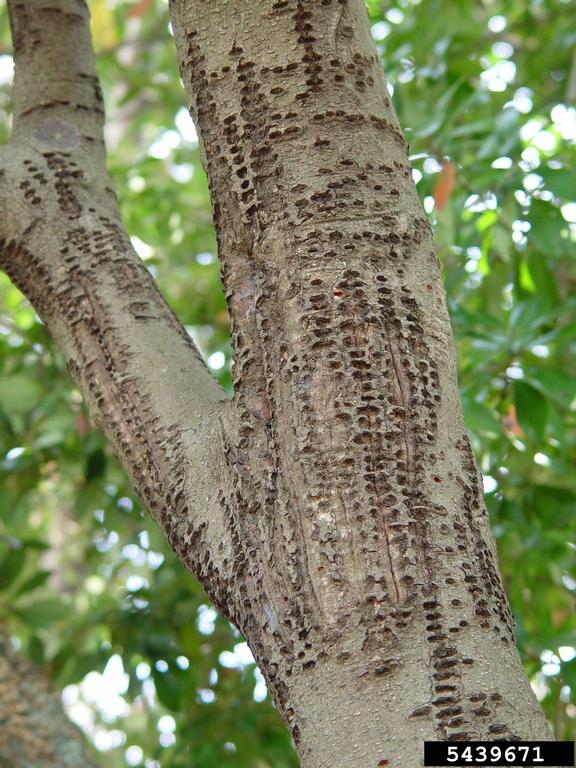 Sapsuckers and their Damage - May 6, 2015 Jeff Schalau, Agent, Agriculture & Natural Resources University of Arizona Cooperative Extension, Yavapai County Woodpeckers, sapsuckers, and flickers are all related and belong to the family Picidae. According to the Verde Valley Birding and Nature Festival Bird Checklist, twelve species might be observed in the greater Verde Valley, Sedona and adjoining canyons and mountains. While these birds are interesting to observe on wild lands, they can also cause minor injuries to trees and sometimes be destructive to structures. However, there are some important things you should know before you attempt to mitigate plant and structural damage caused by birds. In Arizona, all birds except rock doves, starlings and English sparrows are protected under the Migratory Bird Treaty Act of 1918. This federal law makes it unlawful without a waiver to pursue, hunt, take, capture, kill or sell “migratory birds”. When warranted, woodpeckers other than endangered species can be killed, but only under a permit issued by the Law Enforcement Division of the U.S. Fish and Wildlife Service upon recommendation of the United States Department of Agriculture, Animal and Plant Health Inspection Service (USDA-APHIS) Wildlife Services personnel. Acquiring a permit is not a simple process and Rock doves (feral pigeons), English sparrows, and European starlings are the only birds you can legally kill without a permit or hunting license in Arizona. So, put those bb guns away because a violation is a federal offense. Woodpeckers often use houses and sheds in search of food, for as a surface for territorial/social drumming, or for nest construction. Aside from the noise, they can cause structural damage. Pecking damage regularly occurs on wooden siding, eaves, or trim boards. Small gaps provide hidden spaces that harbor insects, which in turn, attract woodpeckers in search of food. They can also peck larger holes in wood siding to create nests in the wall cavity. Damage tends to be on houses in or near natural wooded areas and most often occurs in suburban or rural settings. Part of a woodpecker's breeding behavior is rhythmic tapping or repetitive drumming on wood or other hard surfaces. This practice proclaims their breeding territory and social significance. Woodpeckers prefer drumming surfaces that resonate loudly. Both male and female woodpeckers drum. You may have seen trees with a series of small, evenly-spaced, holes in rows pecked through the bark on the trunk or limb by a sapsucker seeking food. Over time, this continuous activity extends the number of rows of holes. These holes are fairly commonplace in northern Arizona and most trees can tolerate these feeding holes. On occasion, this can kill a limb or allow disease pathogens to enter the plant. The best strategy for limiting their damage is physical exclusion. On structures, install bird-type netting to prevent woodpeckers from gaining access to wood siding or other wood surfaces as the most effective method to stop building damage. Lightweight, plastic, 3/4-inch mesh is stretched from the eaves to a lower point on the building. Alternatively, the netting can be stretched over any flat surface subject to damage, leaving at least three inches of space between the netting and damaged surface so that the birds cannot cause further damage through the mesh. You may also protect trunks or branches of individual plants from excessive damage by wrapping the area with hardware cloth where damage is worst. However, this is usually not necessary. If this strategy is used, be sure that the prevention measure does not cause greater damage to the tree than the sapsucker. Frightening devices (models of hawks, owls, and snakes) are ineffective as frightening devices for these birds. Plastic twirlers, aluminum foil, brightly colored plastic strips and similar objects have been used with inconsistent success. Other devices utilize predator calls from hawks and other birds of prey. Again, these devices are expensive and only work when the bird has not become well-attached to that particular location. Once established, woodpeckers are persistent and are not easily driven from their territory or selected pecking site. Repellents are rarely successful. For woodpeckers/sapsuckers, Tanglefoot (a sticky substance), can be effective in some cases. It is also very messy. When the damage is on plants, do your best to tolerate it – most trees can recover. On structures, create and maintain physical barriers and mend holes as soon as possible. Below is a photo of damage and additional resources on woodpeckers, sapsuckers, and flickers. Follow the Backyard Gardener on Twitter – use the link on the BYG website. If you have other gardening questions, call the Master Gardener help line in the Camp Verde office at 928-554-8999 Ext. 3 or e-mail us at verdevalleymg@gmail.com and be sure to include your name, address and phone number. Find past Backyard Gardener columns or provide feedback at the Backyard Gardener web site: http://cals.arizona.edu/yavapai/anr/hort/byg/. Additional Resources  Sapsucker damage on hardwood tree trunk - many of the wounds have recovered (USDA Forest Service - Region 8 - Southern Archive, USDA Forest Service, Bugwood.org). Woodpeckers University of California IPM www.ipm.ucdavis.edu/PMG/PESTNOTES/pn74124.html Preventing Woodpecker Damage Colorado State University Extension www.ext.colostate.edu/pubs/natres/06516.html Verde Valley Birding and Nature Festival Bird Checklist Compiled by Deana Greenwood and Randy Miller verdebirdingtrail.com/verdelist.pdf |